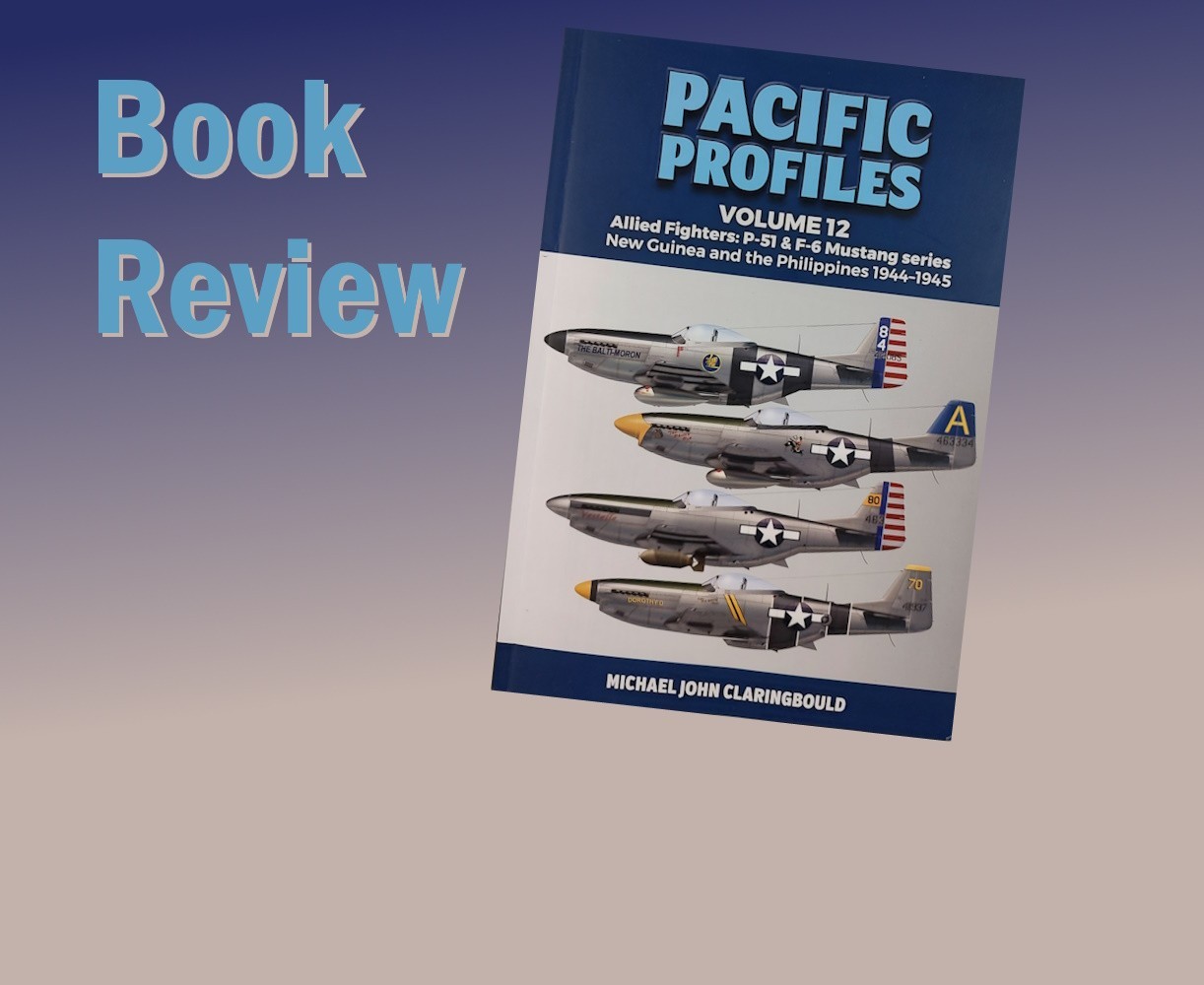
Pacific Profiles Volume 12 Allied Fighters: P-51 & F-6 Mustang series New Guinea and the Philippines 1944-1945 is a new title from Avonmore Books, which specializes in high-quality printing of titles focusing on the air war in the southwest Pacific. This book features original color illustrations, presents fresh information, clarifies facts or corrects longstanding errors perpetuated for decades, and includes new markings and information.
Authored and illustrated by Japanese wartime aviation expert and former diplomat Michael John Claringbould, this book is the fruit of months burrowing into original American records and documents. Composed of 108 pages including the index, full of photos and colorful artwork, it is published by Avonmore Books and catalogued with ISBN 9780645700442. Avonmore tells us:
The Pacific Profiles series presents the most accurate WWII profiles of Allied and Japanese aircraft which served throughout the South and Southwest Pacific theatres. This Volume 12 covers the P-51 and F-6 Mustang series which served in New Guinea, the Philippines and then the Japanese islands, serving with a total of ten USAAF Fifth Air Force fighter and reconnaissance squadrons, and also with New Guinea's Combat Replacement Training Center. The book includes a final chapter of post-war transition markings for the three years until 1948.
Most profiles are presented for the first time, alongside markings derivations, including squadron heraldry and codes. Until now there has been a paucity of markings material about Fifth Air Force Mustang units, especially the tactical reconnaissance and air commando squadrons. Each profile is supported by photos and/or documentation, along with a brief history of each aircraft. Wide-ranging primary reference material is cited including assignment data, squadron records, colour photography, maintenance logs, diaries and factory specifications. A brief history of each unit and the rationale of its associated markings accompanies the text.
The author is world-renowned for his expertise on the Pacific air war. Never before has the USAAF Fifth Air Force Mustang and its colourful markings been illustrated with such breadth, accuracy and detail.
Mr. Claringbould's credentials are mentioned in previous reviews; raised in Port Moresby, Papua New Guinea, these subjects are a life-long pursuit of his and he has authored more than 20 other titles. Most concern the air war in the South Pacific. His series Pacific Profiles currently offers 14 titles, focusing on Allied and Japanese fighters, bombers, transports and miscellaneous types, and Japanese seaplanes. You can view this book on the company website here: Pacific Profiles Volume 12 Allied Fighters: P-51 & F-6 Mustang series New Guinea and the Philippines 1944-1945.
Mustangs are a favorite of modelers. It seems that except for the Very Long Range Mustangs shepherding B-29s over Japan, and maybe China-Burma-India Air Commandos, Pacific War P-51s are overlooked. Which is a shame because, as we will see, Gen. Kenney's "Flying Buccaneers" flew some of the most lavishly decorated P-51s of the war. This book will show how vivid they were.
Content
P-51 & F-6 Mustang series New Guinea and the Philippines 1944-1945 comprises 108 pages (front and rear content inclusive) and 14 chapters.
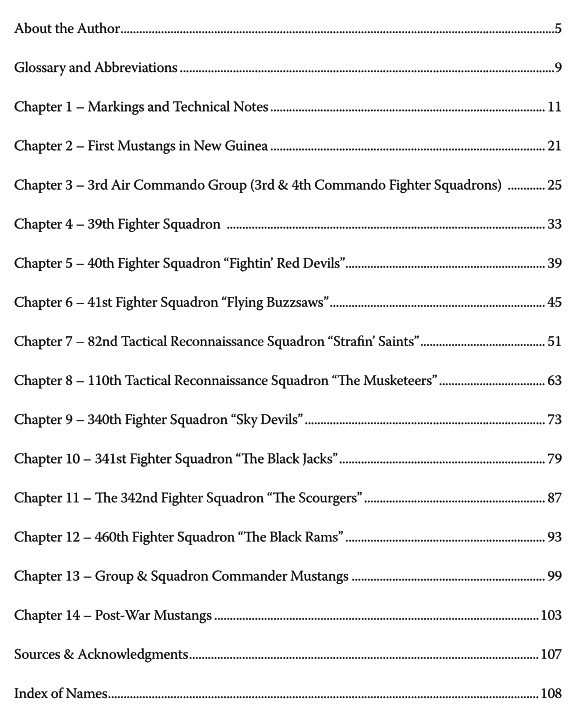
These chapters are abundantly illustrated with photographs and artwork. After a brief introduction about the author, the book presents three pages of two maps, and an instrument approach plate for Finschhafen, New Guinea. Those are followed by Glossary & Abbreviations presents common terms and usage, e.g., FS = Fighter Squadron, Hiko Sentai = Japanese Army Air Force Flying Regiment, CRTC = Combat Replacement Training Center. We also learn the difference between a P-51 and a F-6.
The first chapter is Markings and technical Notes, which offers an interesting history of the Fifth and Thirteenth Air Forces and their merging into the Far East Air Forces (FEAF). It explains FEAF resistance to the P-51 in favor of the P-38 and P-47, P-51 teething problems, and the surprising initial role for the Mustang. (If you know the history of introducing the Mustang into the European Theater of Operations, you may not be surprised - ah, generals, they never learn.) We are immersed into the subject of tactical and technical markings. These include identification markings, national insignia changes, and propeller markings, to name a few.
Chapters 2-14 introduces us to the air units. Pacific Profiles is a wealth of information and each chapter begins with a history of the unit including (when known):
· Commanding officers (and what they did before the war, i.e., Major Archuleta was a school teacher)
· Establishment location and training areas if pertinent
· Base of arrival/operations in-theater
· Aircraft unit codes
· Aircraft manufacturer numbers
· Date of commencement of operations
· Combat
· Losses
· Transfers
· Re-equipping
When available, each unit history includes the record of losses of pilots and aircraft (with name and cause when known), and unit nickname.
Photographs, Artwork and Graphics
As stated in previous Pacific Profile reviews, these books feature an impressive gallery of black-and-white and even color photos to support the text. This books contains several original color photos. They span the gamut of professionally exposed and developed images to amateur pictures. Some are stills taken from motion pictures. Many show damaged aircraft. The author chose excellent images that visually confirm insignias and odd airframe finishes. Many simply amaze me.
Perhaps the most impressive part of the book is the original color artwork by the author of select aircraft. As previously mentioned, each profile is supported by photos and/or documentation. The publisher writes:
Each profile has been produced by citing wide-ranging reference material, including official squadron records, colour movies, maintenance logs, diaries, wreck site inspections and thousands of photos including colour slides.
As in the artist’s other books, weathering and wear is illustrated. His experience as a pilot allows him to render atmospherics for in-flight illustrations.
Many profiles are authenticated with a wartime photograph of the aircraft. Most of the profiles include a line or two of narrative of the history of the aircraft, some consist of a small paragraph.
Artwork
As are the photographs, the illustrations are a treasure trove for modelers. While the academic and technical research is the brain of this book, perhaps the most impressive part is the original color artwork that visually spotlights what the text imparts. The author richly illustrates select P-51s – 104 profiles - and dozens of supporting illustrations. Those renders present unique markings, insignia, and bare metal finishes. Supporting the deployment of P-51s is a map of the combat area showing P-51 bases. Recall that many profiles are authenticated with a wartime photograph of the aircraft.
A. Three pages of renderings reproduce dozens of technical and operational markings.
1. Operating placard: airspeeds; RPMs; Flap and landing gear restrictions.
2. Airframe stenciling: 16 topics, e.g., "DON'T JACK HERE WITH TANK DOORS OPEN"; "EXTERNAL POWER SOCKET 24 VOLTS D.C."; "STEP HERE."
3. 76-gallon drop tank stencil.
4. Aircraft data technical stencil.
5. Hamilton Standard logo.
6. Hamilton Standard technical stencil.
7. Factory numeral stencils.
8. 110th TRS' unique squadron number.
9. Philippines' Theater Markings: 12 spinner decorations; invasion markings shown in profile, head-on, planform, stencil overspray.
B. Scores of aircraft and group/squadron/personal insignias are illustrated.
1. Combat Replacement Training Center: two profiles included a P-51 with its cowling off.
2. 3rd Air commando Group (3rd & 4th Commando Fighter Squadrons): 10 profiles of P-51s and Captain Curdes' kill scoreboard - perhaps the most incredible of the war - all three Axis insignia and an American flag.
3. 39th FS: 8 profiles of P-51s, and the squadron insignia.
4. 40th FS: 10 P-51 profiles; close-ups the unit insignia and personal markings.
5. 41st FS: 10 P-51 profiles; close-up the unit insignia.
6. 82nd Tactical Reconnaissance Squadron (TRS): 12 F-6 profiles; 3 close-ups the unit insignia and personal markings.
7. 110th TRS: 10 F-6 profiles; 4 close-ups the unit logos/personal markings.
8. 340th FS: 8 P-51 profiles; close-up the unit insignia.
9. 341st FS: 10 P-51 profiles; close-up the unit insignia.
10. 342nd FS: 7 P-51 profiles; 2 close-ups of the unit insignia.
11. 460th FS: 5 P-51 profiles; close-up the unit insignia.
12. Group & Squadron Commander Mustangs: 5 P-51 profile; Colonel "Bud" Mahurin's personal logo and scoreboard.
13. Post-War Mustangs: 7 Mustang profiles.
C. In-flight P-51 scenes: 3 aerial views of FEAF Mustangs.
Maps
1. Combat Replacement Training Center, Nadzab 1945.
2. P-51 Main Operational Bases, New Guinea, Philippines & Ryukyu Islands, Far East Air Forces 1944-45.
Aside from the airplanes, modelers will find a wealth of source material for airfield paraphernalia to create and detail dioramas.
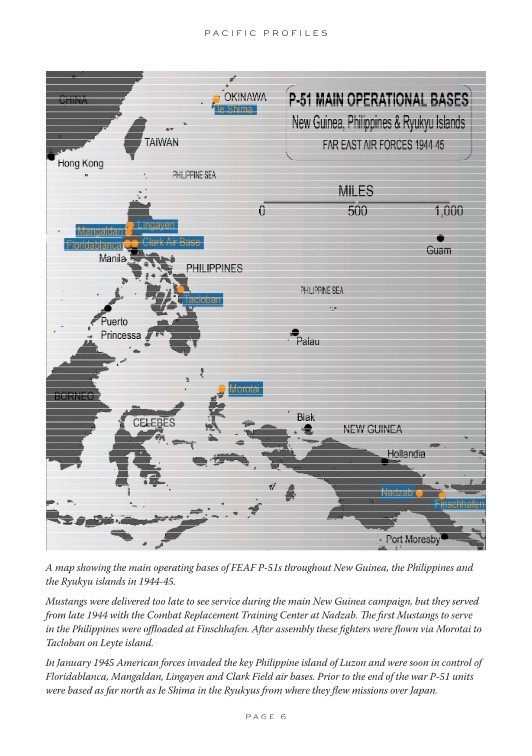
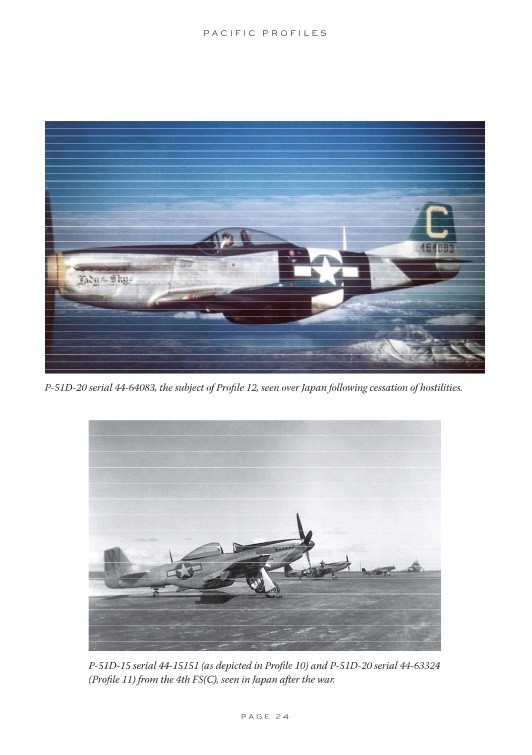
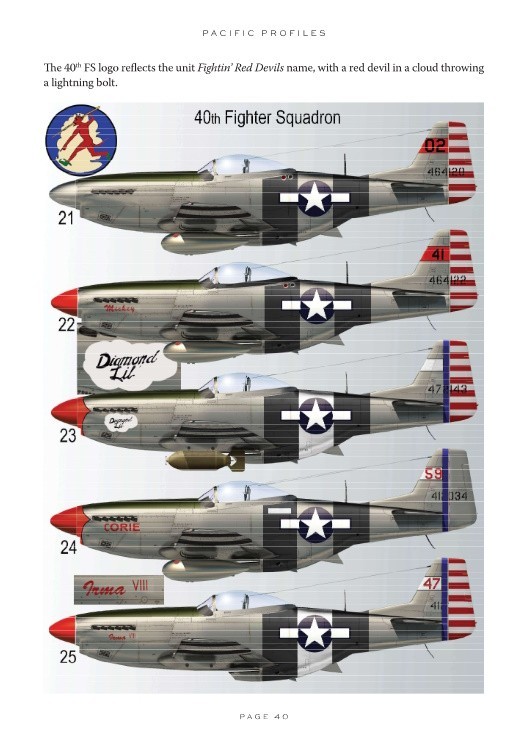
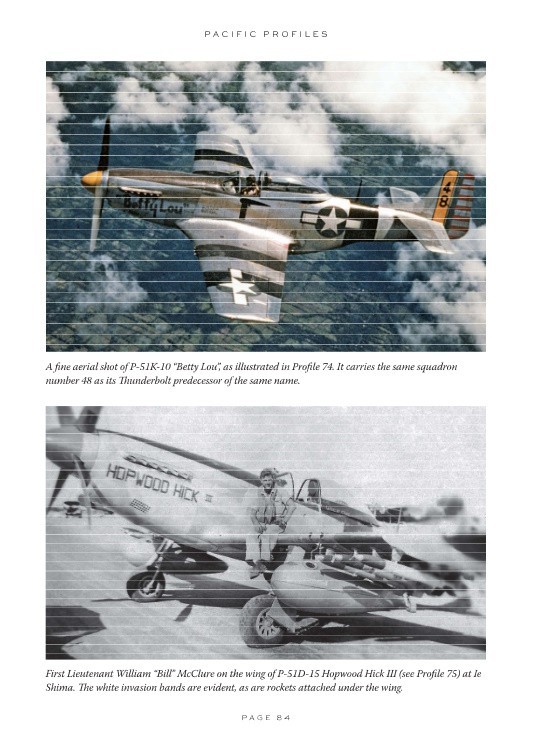
Conclusion
FEAF P-51s were a sight to behold and Avonmore's Pacific Profiles P-51 & F-6 Mustang series presents them with over 100 vivid profiles. The P-51's FEAF introduction story and background of the squadrons are very interesting concise histories in themselves. The accuracy of the color profile interpretations are authenticated by contemporary color photographs.
Modelers of P-51s now have a modern wonderful resource to inspire model subjects. Recommended.
Please remember to mention to Avonmore Books and retailers that you saw this product here - on Aeroscale.











